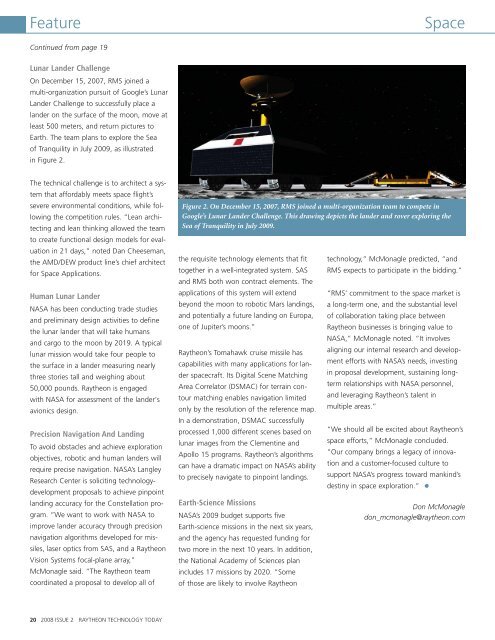2008 Issue 2 - Raytheon
2008 Issue 2 - Raytheon
2008 Issue 2 - Raytheon
Create successful ePaper yourself
Turn your PDF publications into a flip-book with our unique Google optimized e-Paper software.
Feature<br />
Continued from page 19<br />
Lunar Lander Challenge<br />
On December 15, 2007, RMS joined a<br />
multi-organization pursuit of Google’s Lunar<br />
Lander Challenge to successfully place a<br />
lander on the surface of the moon, move at<br />
least 500 meters, and return pictures to<br />
Earth. The team plans to explore the Sea<br />
of Tranquility in July 2009, as illustrated<br />
in Figure 2.<br />
The technical challenge is to architect a system<br />
that affordably meets space flight’s<br />
severe environmental conditions, while following<br />
the competition rules. “Lean architecting<br />
and lean thinking allowed the team<br />
to create functional design models for evaluation<br />
in 21 days,” noted Dan Cheeseman,<br />
the AMD/DEW product line’s chief architect<br />
for Space Applications.<br />
Human Lunar Lander<br />
NASA has been conducting trade studies<br />
and preliminary design activities to define<br />
the lunar lander that will take humans<br />
and cargo to the moon by 2019. A typical<br />
lunar mission would take four people to<br />
the surface in a lander measuring nearly<br />
three stories tall and weighing about<br />
50,000 pounds. <strong>Raytheon</strong> is engaged<br />
with NASA for assessment of the lander's<br />
avionics design.<br />
Precision Navigation And Landing<br />
To avoid obstacles and achieve exploration<br />
objectives, robotic and human landers will<br />
require precise navigation. NASA’s Langley<br />
Research Center is soliciting technologydevelopment<br />
proposals to achieve pinpoint<br />
landing accuracy for the Constellation program.<br />
“We want to work with NASA to<br />
improve lander accuracy through precision<br />
navigation algorithms developed for missiles,<br />
laser optics from SAS, and a <strong>Raytheon</strong><br />
Vision Systems focal-plane array,”<br />
McMonagle said. “The <strong>Raytheon</strong> team<br />
coordinated a proposal to develop all of<br />
20 <strong>2008</strong> ISSUE 2 RAYTHEON TECHNOLOGY TODAY<br />
the requisite technology elements that fit<br />
together in a well-integrated system. SAS<br />
and RMS both won contract elements. The<br />
applications of this system will extend<br />
beyond the moon to robotic Mars landings,<br />
and potentially a future landing on Europa,<br />
one of Jupiter’s moons.”<br />
<strong>Raytheon</strong>’s Tomahawk cruise missile has<br />
capabilities with many applications for lander<br />
spacecraft. Its Digital Scene Matching<br />
Area Correlator (DSMAC) for terrain contour<br />
matching enables navigation limited<br />
only by the resolution of the reference map.<br />
In a demonstration, DSMAC successfully<br />
processed 1,000 different scenes based on<br />
lunar images from the Clementine and<br />
Apollo 15 programs. <strong>Raytheon</strong>’s algorithms<br />
can have a dramatic impact on NASA’s ability<br />
to precisely navigate to pinpoint landings.<br />
Earth-Science Missions<br />
NASA’s 2009 budget supports five<br />
Earth-science missions in the next six years,<br />
and the agency has requested funding for<br />
two more in the next 10 years. In addition,<br />
the National Academy of Sciences plan<br />
includes 17 missions by 2020. “Some<br />
of those are likely to involve <strong>Raytheon</strong><br />
Space<br />
Figure 2. On December 15, 2007, RMS joined a multi-organization team to compete in<br />
Google’s Lunar Lander Challenge. This drawing depicts the lander and rover exploring the<br />
Sea of Tranquility in July 2009.<br />
technology,” McMonagle predicted, “and<br />
RMS expects to participate in the bidding.”<br />
“RMS’ commitment to the space market is<br />
a long-term one, and the substantial level<br />
of collaboration taking place between<br />
<strong>Raytheon</strong> businesses is bringing value to<br />
NASA,” McMonagle noted. “It involves<br />
aligning our internal research and development<br />
efforts with NASA’s needs, investing<br />
in proposal development, sustaining longterm<br />
relationships with NASA personnel,<br />
and leveraging <strong>Raytheon</strong>’s talent in<br />
multiple areas.”<br />
“We should all be excited about <strong>Raytheon</strong>’s<br />
space efforts,” McMonagle concluded.<br />
“Our company brings a legacy of innovation<br />
and a customer-focused culture to<br />
support NASA’s progress toward mankind’s<br />
destiny in space exploration.”<br />
Don McMonagle<br />
don_mcmonagle@raytheon.com
















